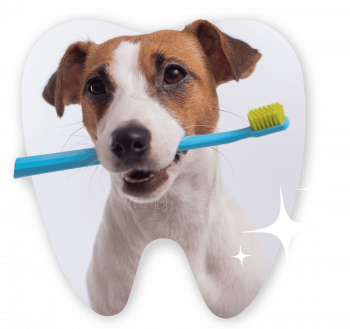Pet Teeth Cleaning
Dental Days Deal
$100 off Dental Cleanings
For new and existing clients!
Call (682) 350-8890 to schedule a cleaning today!

Aug 19 – Sept 30, 2024
*New and existing clients. Canine and feline only. Not valid with other offers. Not redeemable for cash.May use offer on multiple pets within the same household. Not applicable for membership or wellness plans.
Pet Teeth Cleaning in Fort Worth
At VO Vets, we provide pet dental care that goes the extra smile.
Having clean teeth is important to your pet’s health. We offer professional cat and dog teeth cleaning services in Fort Worth, TX that include oral exams, cleaning and polishing, and dental X-rays to check for periodontal disease. Our team also recommends annual exams and teeth cleanings to maintain your pet’s pearly whites. With regular checkups and consistent at-home care, you can prevent periodontal disease and other painful, infectious conditions.
Signs It’s Time for a Pet Dental Visit
Approximately 80% of dogs and 70% of cats aged three and up show signs of dental disease. While there are signs you can look for on your own at home, VO Vets recommends seeing your pet at least once a year for an oral exam and teeth cleaning procedure.
Here are the signs we look for when evaluating your pet’s oral health:
Bad breath (this is never normal for dogs or cats)
Teeth that are loose, missing, or broken
Tooth discoloration/tartar buildup
Reduced appetite, or difficulty chewing
Dropping food
Drooling excessively
Red/swollen gums
Bleeding from the mouth

Pet Dental Care FAQ
Here’s what you need to know about pet dental care at VO Vets.
If your pet needs to see us for a teeth cleaning, we first need to perform an exam and blood work to make sure your pet is healthy and can be safely placed under anesthesia. When they are ready to go into their procedure, we place an IV catheter to deliver the safest form of anesthesia, along with fluids for blood pressure support and to flush toxins out of the body. We may also administer antibiotics if we suspect a bacterial infection in the mouth.
Once your pet is under anesthesia, we will conduct a full, thorough examination of your pet’s mouth. We will check for signs of bone loss, deep pockets around the teeth, loose or broken teeth, oral tumors, and other issues. If necessary, we will perform an extraction to remove a decayed or broken tooth.
For your pet’s teeth cleaning, we will use an ultrasonic scaler to remove hardened tartar from the crown of each tooth. We then perform a root planning procedure to remove plaque and bacteria below the gum line. When all plaque and tartar debris have been removed, we will polish your pet’s teeth and treat the teeth with fluoride afterward.
A full oral assessment isn’t possible for your pet without dental X-rays. Since a majority of the tooth is hidden below the gum line, only X-rays can show us if there are any issues, such as periodontal disease, root fractures, and oral abscesses, brewing under the surface. X-rays are also useful following tooth extractions because they can help us check to make sure the entire tooth has been removed. At VO Vets, we recommend full-mouth dental X-rays for every pet.
STEP 1: SUPRAGINGIVAL CLEANING
Any plaque and tartar that is visible above your pet’s gum line needs to be removed.
STEP 2: SUBGINGIVAL CLEANING
Subgingival cleaning is cleaning done under the gum line. This is extremely important for our patients because most oral pathology occurs under the gums. From a medical standpoint, this is where we can treat gingivitis and dental disease.
STEP 3: ASSESSMENT
Your veterinarian will examine your pet’s entire oral cavity and make note of any abnormal findings in your pet’s medical chart. Abnormal oral conditions may include lesions, deep pockets in the gums surrounding the teeth, and discolored, broken, or loose teeth.
STEP 4: ADVANCED DENTAL IMAGING
We can perform advanced dental imaging of each tooth to check for problems affecting the enamel, roots, and jawbone.
STEP 5: POLISHING
When we remove plaque and calculus from your pet’s teeth, it results in microscopic roughening of the tooth surface. To prevent future plaque from clinging to this roughened surface, we polish the enamel to make it smooth and reduce plaque buildup.
STEP 6: SUB-GINGIVAL LAVAGE
While we’re scaling your pet’s teeth to remove tartar and calculus, this can result in debris getting stuck under the gums and causing local inflammation. To prevent this, we carefully flush out the gums using an antibacterial rinse.
STEP 7: FLUORIDE TREATMENT
Fluoride makes your pet’s tooth enamel stronger and more resistant to plaque. It can also reduce sensitivity. After applying fluoride treatment to your pet’s teeth, we will rinse it away thoroughly to prevent it from being swallowed.
STEP 8: TREATMENTS
If our team finds any problems during your pet’s oral assessment and advanced dental imaging, we can provide the necessary treatments to resolve them. This may include placing bonded sealants for minor tooth fractures, extracting a damaged tooth, and applying antibiotic to pockets around the teeth. Your vet will also discuss treatment options you can utilize at home to maintain your pet’s oral health.
STEP 9: PREVENTION
After your pet’s teeth cleaning procedure, we will be happy to discuss ongoing preventative care. Teeth brushing can maintain your pet’s oral health between teeth cleanings, minimizing plaque buildup and keeping dental disease at bay. However, professional cat and dog teeth cleanings at VO Vets are still recommended once a year to protect your pet from oral infections, which could develop into systemic disease without timely treatment.
Dogs and cats will instinctively hide their pain, so it isn’t easy for pet owners to see when something is wrong. Many pets will continue eating regardless of their discomfort. Some ways you might be able to tell if your pet is in pain include sleeping more often, increased licking, altered breathing, and changes in posture.

